
Werra
The Werra was an eye-catching futuristic-looking range of cameras produced from 1954 until about 1967 by Carl Zeiss Jena, better known for their Carl Zeiss lenses. A wide range of models was available with a basic model to which various features were added. Other than the first few versions, all had Tessar lenses and most were available in olive green or black.
A rather unique feature of the Werras was the method of film advance and shutter cocking, which was done by a small twist of the lens base, the ring around the lens barrel. This made the camera quick to use. A nice design feature was that the lens cover also served as a lens hood simply by mounting it in reverse. Below follows an overview of the various Werra types and models.

An overview of various Werra types, going from left to right: (front row) Werra 1, Werra 2, Werra 3, (back row) Werra 5, Werramat, Werramatic. The different styles are also visible, the flat topped early versions (two front right), rounded later versions without accessory shoe (two back left) and the final version with rounded top, accessory shoe and striped viewfinder frame (back right, front left). Several earlier versions are show below.
The basic Werra model range was marketed as Werra I-IV and featured a viewfinder, an uncoupled lightmeter, a rangefinder, and a rangefinder plus uncoupled lightmeter, respectively. The Werra III and IV had interchangeable lens mounts. Later, a Werra V was added which had a coupled lightmeter. The latter was later renamed to Werramatic and the final addition to the range was the Werramat, essentially a Werra II but with coupled lightmeter.
In addition to this naming scheme, the Werra went through several cosmetic changes. The first type had a rectangular body with a flat top and sharp edges. It was covered in olive green leather although some variants were available in black also. The second type had more rounded edges and curved top. It was mainly available in black. The third and last type had a striped plastic face plate around the viewfinder area and an accessory shoe. It was available in a black herringbone cover only.
This relatively straightforward naming scheme had a lot of small variations, as different features were introduced at different times on different models. In addition, many models were available with Carl Zeiss' own Prestor shutter as well as the better-known Synchro-Compur shutter. Finally, the very first model was simply called Werra (without roman numeral) and went through a couple of changes before the Werra I-IV range was introduced. Note that this range was also indicated as Werra 1-4, although possibly only from around the time when the Werramat and Werramatic were introduced.
Werra
The first Werra was introduced in 1954 and it laid the base for all Werras to follow, having all main features like the lens twist film advance, the clean and uncluttered appearance, the removable back, the lens cover doubling as lens hood, and the frame counter and rewind knob at the bottom of the camera. It had a coated Novonar f/3.5 lens and a Vebur shutter with a top speed of 1/250 and slow speeds down to 1s. The film advance ring at the base of the shutter was serrated and made of plain aluminium. They were covered in green leather and had matching carrying straps and case, which are difficult to find these days.
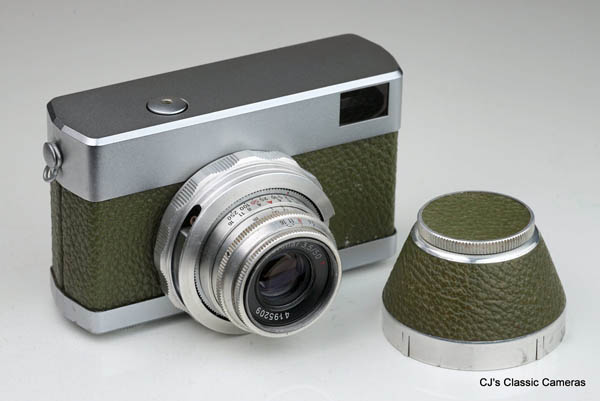
The first Werra, easily recognisable by its serrated aluminium film advance ring. This first production model had its flash sync socket mounted on the shutter, accessible through a gap in the film advance ring. As far as I am aware this type all had Novonar 50mm f/3.5 triplet lenses, early ones of which were marked 'Optik Saalfeld' after the Carl Zeiss daughter factory where these were made.
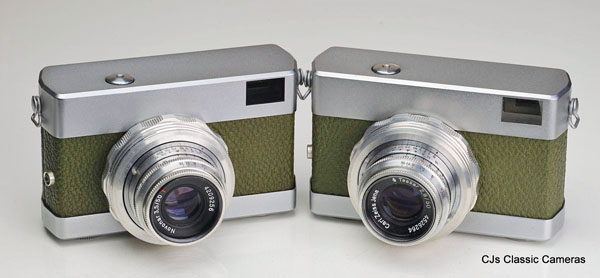
These are examples of the second production type, which had a flash sync socket mounted on the body. Early production (left) all had Novonar 50mm f/3.5 triplet lenses, later production (right) was also available with four-element Tessar f/2.8 lens.
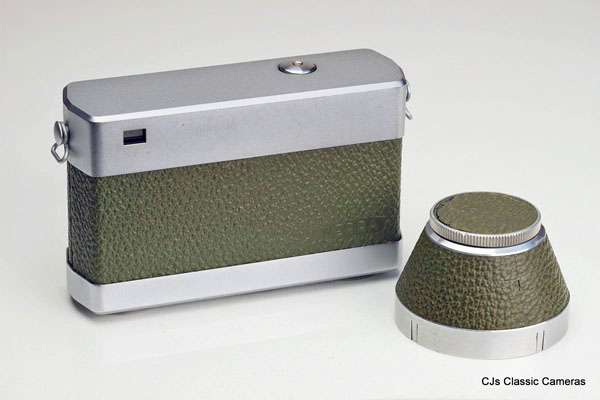
Rear view of the first Werra, which was nearly featureless apart from the tiny eye piece. Already on the next Werra model this was replaced by a larger round one with adjustable dioptre. Also shown is the lens cover/hood, which was a simple clamp-on type for the early Werra, as opposed to the screw-in types on later models.
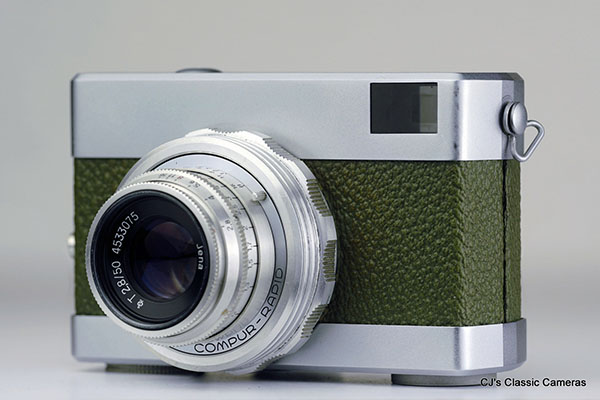
A rare variant of the Werra 0 with a Compur-Rapid shutter. I wasn't aware this version existed until I saw one for sale. Later Werra models were available with Synchro-Compur shutters as an alternative to the more common in-house Prestor shutter, and some examples can be seen below, but a Compur-Rapid (the predecessor of the Synchro-Compur) I had not seen, nor had I seen a shutter other than a Prestor on the Werra 0.
Another unusual feature of this particular Werra is that the lens does not show the name Tessar but only a 'T' instead. I wrote about this elsewhere, but essentially this was to avoid trade-mark problems with Carl Zeiss' (estranged) sister company Zeiss Ikon, which also made Tessar lenses.
Werra I
The Werra 1 (or Werra I; Roman and Arabic numerals are used interchangeably in manuals and other literature) replaced the original Werra above and was mostly a cosmetic update, although under the hood there were quite a few changes to accommodate several common components needed for the more advanced Werra models.
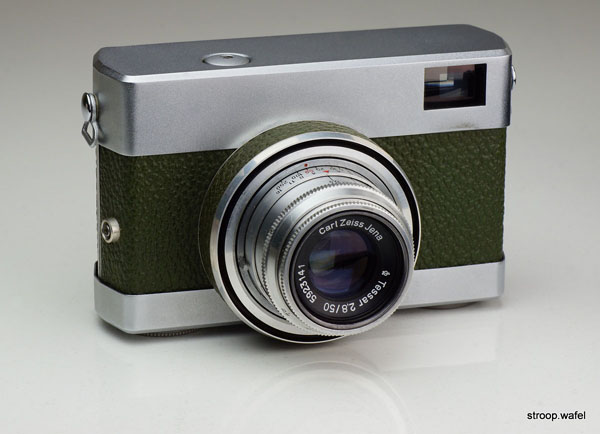
First version of the Werra I, the most basic model without rangefinder or light meter and a fixed lens.
The lens cover doubled as a sun shade. A cool feature but in practice a little cumbersome as one had to unscrew the lens cap, then screw on the sun hood, and afterwards, screw the lens hood back onto the body and then screw on the lens cap.
The second Werra I was a minor upgrade from the first version, having a better viewfinder with a reflective frame. You can recognise this model from the back side only, as the eye piece is larger and has a rectangular metal frame, as shown in the picture on the left. This particular example has a Synchro-Compur shutter, which was an alternative to the standard Prestor-SVS. The Syncro-Compur had a top speed speed of 1/500 s compared to 1/250 s for the Prestor, although the latter was soon to be upgraded to a very fast 1/750 s.
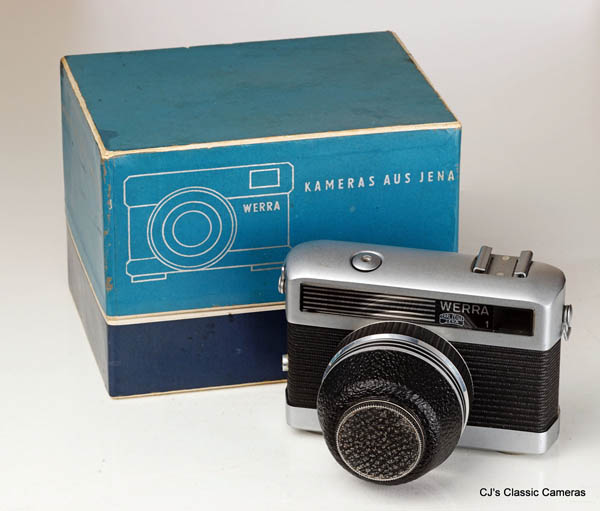
The last version of the Werra I shown here with its original box and with lens hood mounted. Little had changed in functionality of the camera from the very first version, but its design was updated. Not for the better, in my opinion, but that's a matter of taste of course.
Werra 2
The Werra 2 was a fixed-lens viewfinder camera with an uncoupled lightmeter. Quite a few varieties exist - in fact I think this is the model with the most variants. The very earliest version had a knurled aluminium film advance ring and a Novonar lens, just like the original Werra. This was followed by a model similar to the early green Werra I above but with a square-framed eyepiece. This version was also available with a Synchro-Compur shutter. The follow-up model can be seen below. A later version of that model had an accessory shoe added, which I think is the only version of this body style that had one. The final Werra 2 has the more plasticky and stripy look of the late Werra I shown above.
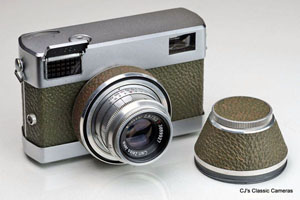

Early version of the Werra 2 with olive-green leather. This is one of the few models with a rectangular frame eyepiece, also found on late examples of the olive-green Werra I (see above). It was an Albada-style viewfinder with a silvered projection of the frame shown in the viewfinder, including parallax marks. The later viewfinders with round eyepieces were prism viewfinders that showed projected viewing frames and had an adjustable dioptre for eyesight correction. The earlier ones with small rectangular eyepiece were reverse Galilean type with no frames or parallax marks shown.

A later version Werra 2 with removable accessory shoe mounted. It was very similar to the ealier model but had a higher top shutter speed of 1/750s and a better viewfinder with diopter adjustment.
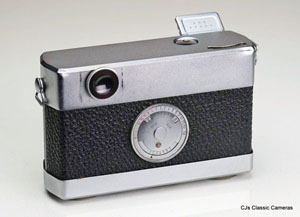
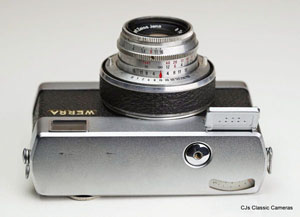
Rear and top view of the Werra 2. The back of the Werra 2 had a lightmeter dial, the only Werra to have that feature. Essentially, one used the lightmeter window visible on top of the camera to read off the light value indicated by the meter (1-7). One could then determine the appropriate aperture-shutter speed combinations. Note that the aperture values are quite faded on this example, they are just about visible at the top of the inner circle. This was the last Werra 2 model to feature a lightmeter dial; later models had a lightmeter window that showed the exposure settings directly.
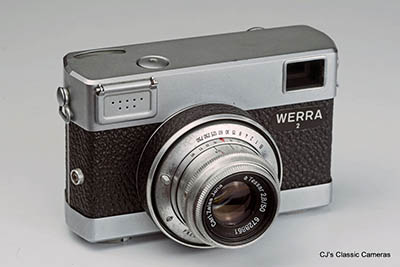
| |
A slightly different and later Werra 2, the main difference being the label, which on this version showed the model number (2), and the font was also somewhat different.
|
Werra 3
The Werra III had a rangefinder as well as an interchangeable lens mount, which allowed the mounting of the two accessory lenses for the Werra system: the Cardinar 100mm f/4 telelens with five elements in four groups, and the Flektogon 35mm f/2.8 wide angle lens with six elements in five groups (see Werra V below for photos). Both lenses were coupled to the rangefinder and were available in black or olivine green leather styling, so one could match the colour scheme of their Werra body. Frame lines were shown in the viewfinder window for 50mm and 100mm field of views, whereas the full view would represent that of the 35mm lens. See under Werra 5 for an image through the viewfinder.

A Werra III, the rangefinder model with interchangeable lens mount. Note that this version still has the same body shape as the early Werra models, but has small frames around the view and rangefinder windows. Some other models that look otherwise very similar already had the rounded body shape typical of later versions, see for instance the Werramat further down.
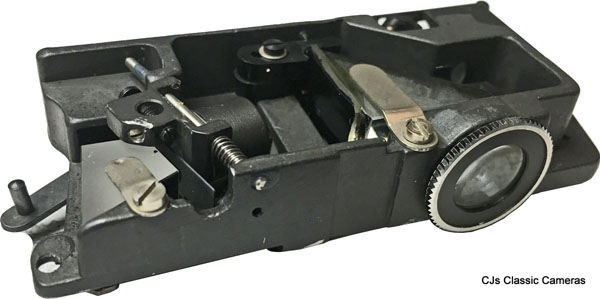
Rangefinder module of the Werra viewed from the bottom. The part was similar on all Werras with small modifications based on the model. This one actually comes from a Werramatic, as it has a lightmeter coupling lever, but the other than the Werra III module is the same. The part on the left with long rod and the spring is the part that moves when adjusting the lens focus, to the front and the back in this view. The adjustment screw and the locking screw for horizontal rangefinder patch adjustment are visible just above the small prism on the left. The prism itself determines the vertical position of the rangefinder patch, it can be adjusted with two screws on top of the unit (not visible), both secured by hexagonal nuts.
Werra IV
The Werra IV was the most advanced Werra model of the original Werra range. The Werra IV had a coupled rangefinder, an interchangeable lens mount and an uncoupled lightmeter. The first version had olive green leather like the rest of the Werra range and looked very similar to the Werra II except for the added rangefinder window and the somewhat larger lens mount. A later version was black with chrome frames around the rangefinder windows, again in line with cosmetic changes to the rest of the Werra range, an example of which is the Werra 3 above.
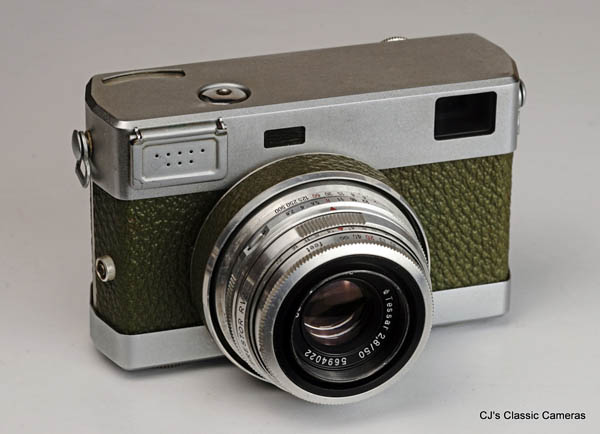
Olive green version of the Werra 4 with its standard Tessar 50mm f/2.8 lens mounted. Two other lenses were available, a wide angle Flektogon and a tele Cardinar (see below), which themselves were available with olive green and with black leather details.
Werra V
The Werra V was a further development of the Werra IV, having a rangefinder and interchangeable lens, as well as a coupled lightmeter, the needle of which was projected in the viewfinder. It was soon after replaced by the Werramatic, which was very similar but had no flap covering the lightmeter cell. The Werra V was available in two versions, an olivine green one which only showed the name Werra faintly on the back, and a black version with a WERRA logo on the front.
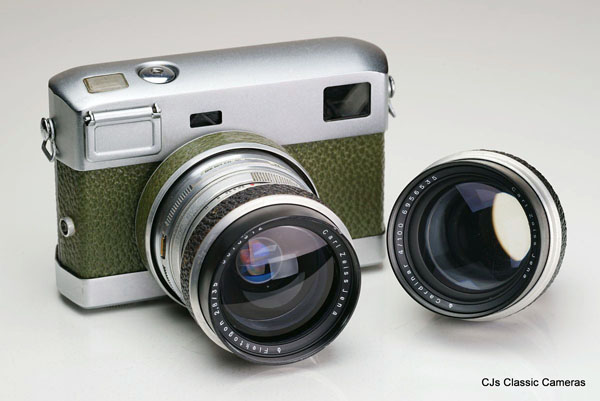
Olive-green version of the Werra V with the Flektogon 35mm f/2.8 wide angle lens mounted. The Cardinar 100mm f/4 telelens is shown on the side. These accessory lenses were a little larger than the standard Tessar 50mm lens, but still very compact and fitted on the body very comfortably.
This model confused me, as it has the rounded body of the later Werras, but lacks frames around the viewfinder and rangefinder windows, which is a feature of the early Werras.

Werra V with its lens unmounted, showing the rather small opening in front of the shutter. Other leaf shutter cameras with interchangeable lenses (Futura, Altix, Prominent, Akarex, to name a few) often had wider openings, presumably to allow faster lenses to be mounted. The fastest lens available for the Werra system had an f/2.8 aperture.
 | This is the view through the Werra 5/Werramatic viewfinder. The Werra 3 viewfinder was similar but lacked the lightmeter indicator at the bottom. Aperture and shutter speed settings are shown in the bottom corner, here partially obscured as the camera I used to take this shot differs from the human eye. The inner two frames are for the 50mm and 100mm lenses. The short thin horizontal and vertical lines are parallax markers. |
Werramat
The Werramat was a further development of the Werra II above. It featured a coupled selenium cell lightmeter, the needle of which was projected in the viewfinder. Also visible in the viewfinder were the exposure settings on the aperture and speed rings through an intricate set of mirrors and prisms. The Werramat was available in two different versions, both of which are shown below. The earlier one was in the style of the early Werras with rounded body edges, whereas the later one had a wide plastic front cover which integrated lightmeter and viewfinder, featured an accessory shoe, and had a herringbone textured body covering instead of the leather on earlier models.
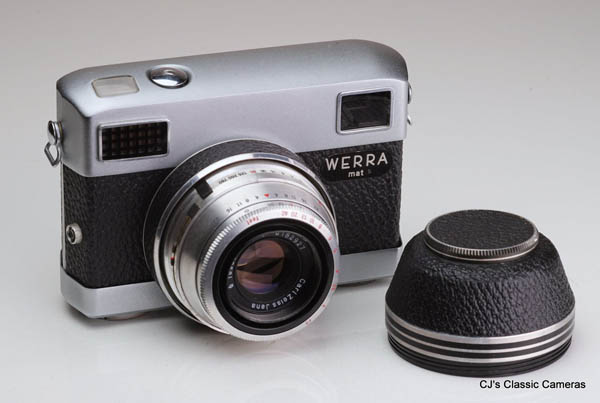
First version of the Carl Zeiss Jena Werramat with Tessar lens in Prestor-RVS shutter. The lens on the Werramat was not interchangeable. On this example the name 'WERRA mat' is printed on the front, but an otherwise identical model that just has 'WERRA' printed can also be found.
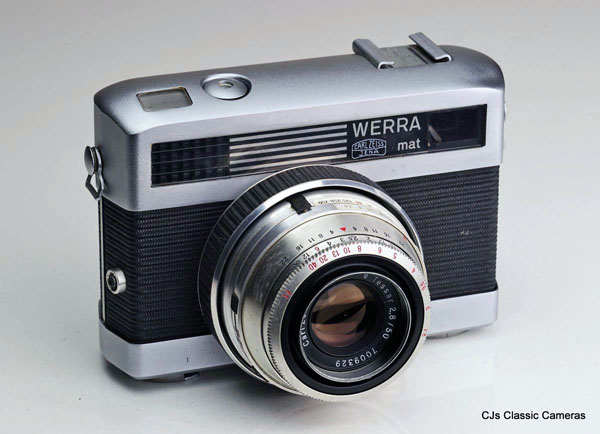
Second version of the Carl Zeiss Jena Werramat with Tessar lens in Prestor-RVS shutter. This shutter was a bit of a nightmare to work on, as the various components were screwed in from behind, which means the whole shutter needs to be dismantled, including a second set of shutter blades (see separate item about this shutter below).

Wind mechanism of the Werramat exposed after removing top cover and viewfinder module. Simple but effective summarises it well. This one was actually jammed by a small bit of plastic (still visible), the exact same bit that's missing from the shutter speed ring. How that got there is anyone's guess.
A more common fault is that the rotating collar around the shutter release shaft is gummed up. This collar controls the double exposure prevention mechanism, and if it is stuck the camera will neither wind nor fire. A clean and regrease usually fixes it.
Werramatic
The Werramatic was the most advanced of all Werras. It came in two versions, basically the same as the Werramat above but with added rangefinder windows. Especially the later version can easily be confused with the Werramat as they look so similar, but the name is printed next to the viewfinder window. Of course the Werramatic featured an interchangeable lens mount, but the design was such that one could easily be fooled into thinking the lens was fixed.
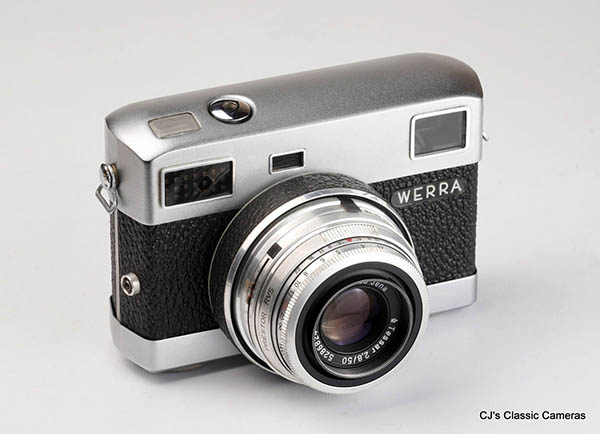
An early version of the Werramatic, only distinguished from the very similar Werra V by not having a flap in front of its lightmeter. The name is a bit uncertain, but for the similarly styled Werramat there is a version that says 'Werra mat' on the front (as can be seen a few photos earlier on this page), and I assume there may be a version of this Werramatic that has its name on the front as well.

A late version of the Werramatic with its matching lens hood.
Prestor-RVS shutter
Most Werra models were available with either a Synchro-Compur or Carl Zeiss own Prestor-RVS, which had the fastest speeds of the two, namely 1/500 on the earliest models and 1/750 on the black models (the Synchro-Compurs were 1/250 and 1/500, respectively). These fast speeds were all the more remarkable considering the large shutter diameter needed for the whole lens was mounted in front of the shutter in order to make them interchangeable. The way this was achieved was by a different shutter design. In most leaf shutters, the shutter blades swing back and forth when the shutter opens and closes. This limits the maximum speed of the shutter due to the inertia of the blades. In the Prestor-RVS the blades were shaped such that the shutter opened and closed in one move of the blades, resulting in a faster action. A drawback of this design was that to cock the shutter, the blades had to go back to their original position, which meant the shutter would open and close during cocking also. Therefore these shutters had a second set of blades which would only open when the shutter was fired. Note that these shutters were fully flash synchronised, even at these high speeds.
One would think Carl Zeiss would have used these fast shutters to promote their cameras, but I have never seen it specifically mentioned it in any of their brochures.
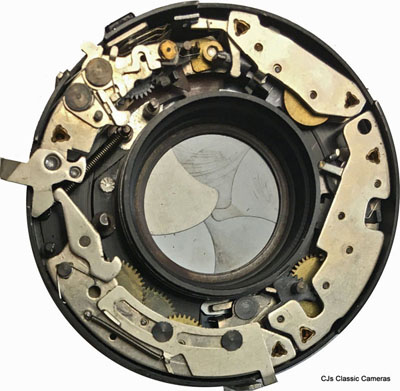
|
Photo of Prestor-RVS shutter with front plate removed. The individual modules such as speedcam (right) and time delay (bottom) are screwed in from the back, which means that to remove them, one needs to remove the shutter blade assembly from the back of the shutter, which makes it all pretty fiddly. On most other common shutters such as the Compur (Rapid), Synchro-Compur and Prontor-S/SV/SVS one case remove these parts from the front, often without removing the shutter from the camera.
|
Other Werras / accessories
The Werra was also available as several specialty versions, including one that could be mounted to a microscope. The throat size of the regular shutter on the Werra was too small to be mounted on a microscope, therefore it was fitted with a much larger dial-set Prontor-Press shutter.
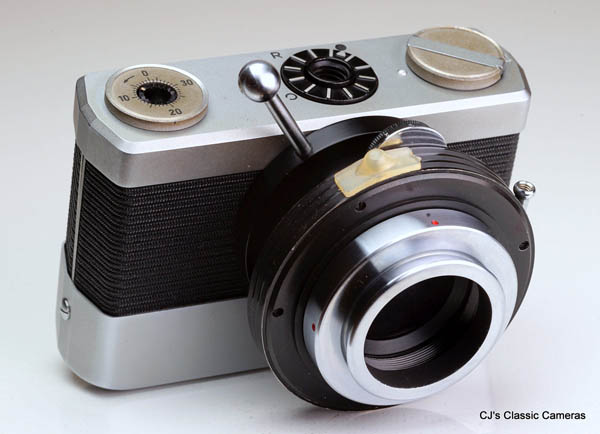
Carl Zeiss Jena Werra microscope camera. The lever with the ball at the end was used to advance the film. A remote release was the most convenient way of firing the shutter.
Not many accessories were available for the Werra range, but there was a set of close-up lenses which came with a set of heavy duty spectacles to adjust the view of the range and viewfinder finder for close focussing. It was called 'Nacheinstellger t', a German word which loosely translates as close-up tool.
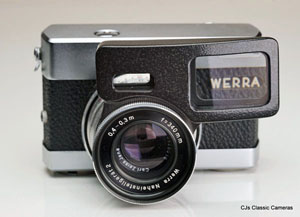
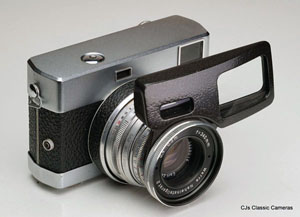
Werra III with close-up attachment #2 for focus distances from 30-40 cm.
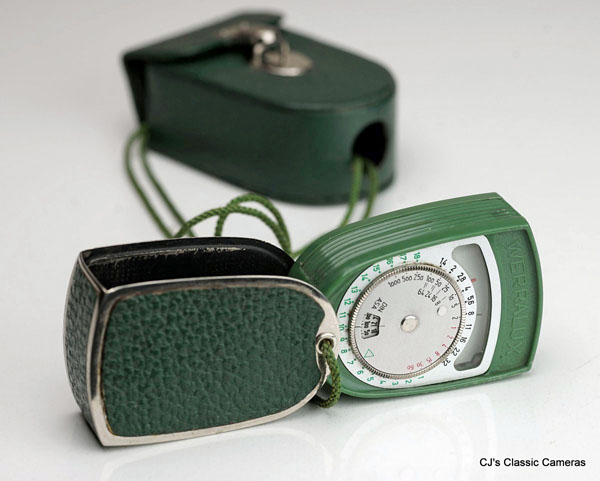
Carl Zeiss also produced a Werra-styled lightmeter, the Werralux. This example has was fashioned in green, but the leather had a darker shade than the olivine green of the Werra cameras.
| 
